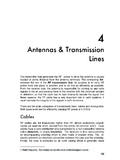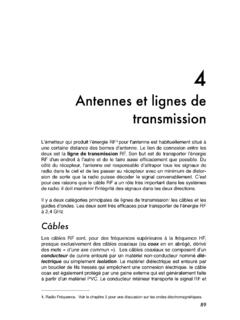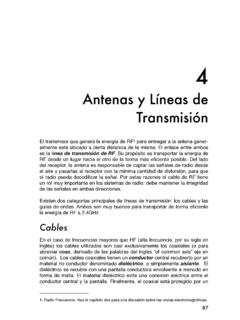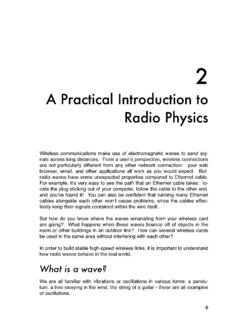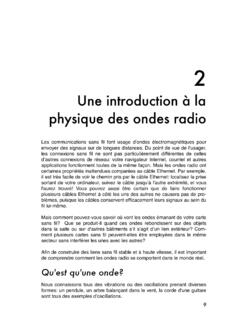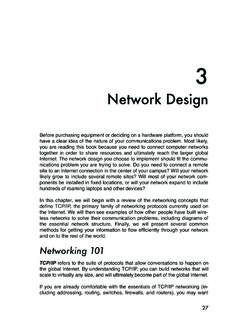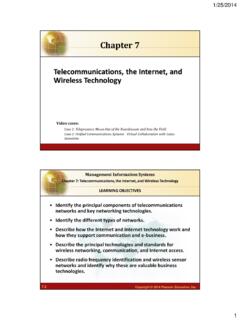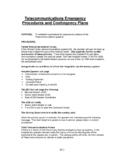Transcription of 2. TELECOMMUNICATIONS BASICS - WNDW
1 2. TELECOMMUNICATIONS BASICSThe purpose of any TELECOMMUNICATIONS system is to transfer information from the sender to the receiver by a means of a communication information is carried by a signal, which is certain physical quantity that changes with time. The signal can be a voltage proportional to the amplitude of the voice, like in a simple telephone, a sequence of pulses of light in an optical fibre, or a radio-electric wave irradiated by an analog signals, these variations are directly proportional to some physical variable like sound, light, temperature, wind speed, etc. The information can also be transmitted by digital binary signals, that will have only two values, a digital one and a digital zero.
2 Any analog signal can be converted into a digital signal by appropriately sampling and then coding it. The sampling frequency must be at least twice the maximum frequency present in the signal in order to carry all the information contained therein. Random signals are the ones that are unpredictable and can be described only by statistical means. Noise is a typical random signal, described by its mean power and frequency distribution. A signal can be characterised by its behaviour over time or by its frequency components, which constitute its spectrum. Some examples of signals are shown in Figure TB TB 1: Examples of signalsAny periodic signal is composed of many sinusoidal components, all of them multiples of the fundamental frequency, which is the inverse of the period of the signal.
3 So a signal can be characterised either by a graph of its amplitude over time, called a waveform, or a graph of of the amplitudes of its frequency components, called a TB 2: Waveforms, Spectrum and filtersFigure TB 2 shows how the same signal can be seen from two different perspectives. The waveform can be displayed by an instrument called an oscilloscope, while the spectrum can be displayed by what is called a Spectrum Analyzer. The spectrum distribution relays very important information about the signal and allows for the intuitive understanding of the concept of filtering of electrical signals. In the example shown, the signal is formed by the superposition of three sinusoidal components of frequency f1, f2 and f3.
4 If we pass this signal through a device that will remove f2 and f3, the output is a pure sinusoidal at frequency f1. We call this operation Low Pass filtering because it removes the higher frequencies. Conversely, we can apply the signal to a High Pass Filter , a device that will remove f1 and f2 leaving only a sinusoidal signal at the f3 frequency. Other combinations are possible, giving rise to a variety of filters. No physical device can transmit all the infinite frequencies of the radio-electric spectrum, so every device will always perform some extent of filtering to the signal that goes through it. The bandwidth of a signal is the difference between the highest and the lowest frequency that it contains and is expressed in Hz (number of cycles per second).
5 While travelling through the communication channel, the signal is subject to interference caused by other signals and is also affected by the electrical noise always present in any electrical or optical component. Intra-channel interference originates in the same channel as our signal. Co-channel interference is due to the imperfection of the filters that will let in signals from adjacent , the received signal will always be a distorted replica of the transmitted signal, from which the original information must be retrieved by appropriate means to combat the effect of interference and noise. Furthermore, the received signal will be subject to attenuation and delay that increase with the distance between the transmitter and the TB 3.
6 Attenuation and delayAlthough it is relatively simple to restore the amplitude of signal by means of an electrical amplifier, the components of the amplifier will add additional noise to the signal, so at very long distances where the received signal is feeble, the amplifier will produce a signal so garbled with noise that the information originally transmitted will no longer be way to address this problem consists in converting the continuous quantity carrying the information into a sequence of very simple symbols which can be easier to recognise even at great distance. For instance, the flag of a ship is a convenient way to distinguish the nationality of the ship even at distances at which the letters on the hull cannot be technique has been extended to carry generalised messages by assigning different position of flags to every letter of the alphabet, in an early form of long distance TELECOMMUNICATIONS by means of digital or numeric signals.
7 The limitation of this method is obvious; to be able to distinguish among, say, 26 symbols corresponding to each letters of the alphabet, one must be quite close to the communicating ship. On the other hand, if we code each letter of the alphabet in a sequence of only two symbols, these symbols can be distinguished at much longer distance, for example the dot and dashes of the telegraph process of transforming a continuous analog signal into a discontinuous digital one is called Analog to Digital Conversion (ADC), and conversely we must have a Digital to Analog Converter (DAC) at the receiving end to retrieve the original is the reason why most modern telecommunication systems use digital binary signals to convey all sorts of information in a more robust way.
8 The receiver must only distinguish between two possible symbols, or in other words between two possible values of the received bit (binary digit). For instance, the CD has replaced the vinyl record, and analogue television is being replaced by digital television. Digital signals can use less bandwidth, as exemplified by the digital dividend currently being harnessed in many countries which consists in bandwidth that has become available thanks to the transition from analog to digital transmission in TV in the process of converting from an analog to a digital information system there is always some loss of information, we can engineer the system so as to make this loss TB 4: Undersampled ImageFor example, in a digital camera we can choose the number of bits used to record the image.
9 The greater the number of bits (proportional to the amount of megapixels), the better the rendering, but more memory will be used and longer time to transmit the image will be most modern communication systems deal with digital signals, although the original variable that we want to transmit might be analog, like the voice. It can be shown that any analog signal can be reconstructed from discrete samples if the sampling rate is at least twice as high as the highest frequency content of the signal. Figure TB 5: detection of a noisy signalThen each sample is coded in as many bits as necessary to achieve the desired amount of precision. These bits can now be efficiently stored or transmitted, since for the recovery of the information one needs to distinguish among only two states, and not among the infinite nuances of an analog is shown in Figure TB 5, where the original data consists of the 0 1 0 1 1 1 0 sequence.
10 The 0's are represented as zero volts and the 1's as 1 V. As the signal moves towards the receiver, its amplitude will diminish. This effect is called "attenuation" and is shown in the figure. Likewise, there will also be a delay as the signal moves from the transmitter to the receiver, the variability in the delay of the received signal is called jitter. Attenuation, noise or jitter (or their combination) if severe enough, can cause a detection error. An amplifier can be used to overcome the attenuation, but the electrical noise always present in the system will add to the received signal. The noisy received signal is therefore quite different from the original signal, but in a digital system we can still recover the information contained by sampling the received signal at the correct time and comparing the value at the sampling time with a suitable threshold voltage.
